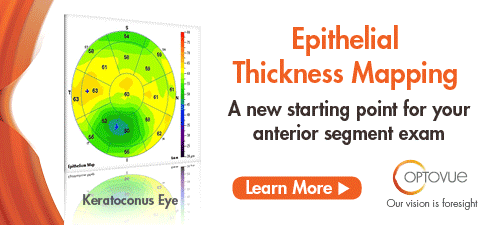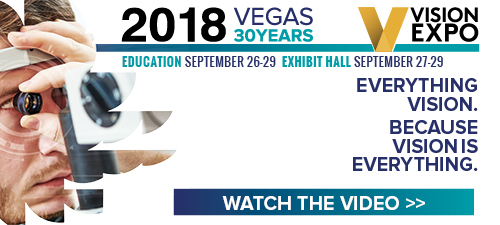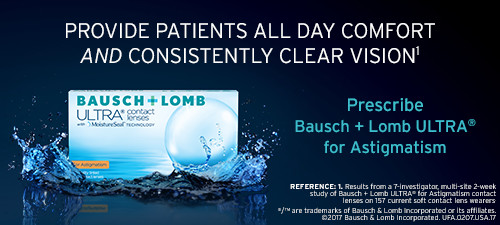
A
weekly e-journal by Art Epstein, OD, FAAO
Off the Cuff: All Roads Lead to Inflammation
I get a lot of questions—especially about "dry eye". By far the most common is some variation of what treatments do I use and when do I use them? I usually start by explaining that the answer isn’t that simple. After years of almost exclusively focusing on "dry eye", I’ve come to realize that successfully treating a "dry eye" patient is like putting together a giant jigsaw puzzle—no two puzzles are the same. Thankfully, there are some commonalities among patients that can make things easier, especially if you have some idea of what you are aiming for and then figure out how to accomplish it.
|
|||||
 |
||
| Prevalence of Keratoconus Among Patients Seeking Laser Vision Correction in Taif Area of Saudi Arabia | ||||
These researchers aimed to determine the prevalence of keratoconus among patients seeking laser vision correction (LVC). The retrospective study included 1,374 eyes of 687 patients (335 males, 352 females) who underwent keratoconus screening as a part of routine preoperative evaluation prior to LVC at the Tadawi surgical centre in Taif, Saudi Arabia, from January 2014 to June 2015. The diagnosis of keratoconus was based on evaluation of Pentacam-derived parameters. Manifest keratoconus was found in 59 subjects (out of 687 subjects), representing a prevalence rate of 8.59%. Of the 687 subjects, 45 subjects (6.55%) had bilateral manifest keratoconus (manifest keratoconus in both eyes or manifest keratoconus in one eye and subclinical in the contralateral eye) and the remaining 14 patients (2.04%) had unilateral manifest keratoconus (with a normal fellow eye). Subclinical keratoconus was diagnosed in 65 patients, representing a prevalence rate of 9.46%. Of the 687 patients, 20 cases (2.91%) with subclinical keratoconus were bilateral and 45 (6.55%) were unilateral. Overall, 19.70% of males (66/335) and 16.48% (58/352) of females had either manifest or subclinical keratoconus, representing no statistically significant difference in the gender predisposition of the keratoconus disease process. High prevalence of keratoconus was found among patients seeking LVC. Possible factors contributing to the high prevalence were recognized to be highly selective population (patients seeking LVC for myopia/hyperopia/astigmatism), ethnicity (high prevalence of consanguinity) and geographical location (high altitude) of the study subjects. |
||||
SOURCE: Althomali TA, Al-Qurashi IM, Al-Thagafi SM, Mohammed A, Almalki M. Prevalence of keratoconus among patients seeking laser vision correction in Taif area of Saudi Arabia. Saudi J Ophthalmol. 2018;32(2):114-118. |
||||
|
||||
| Risk Factors for Retinal Redetachment After Silicone Oil Removal: A Systematic Review and Meta-Analysis | ||||
This systematic review and meta-analysis measured risk factors for retinal redetachment (re-RD) after silicone oil removal (SOR) in a quantitative method. A comprehensive literature review relating to risk factors for re-RD after SOR was conducted before March 2017. Odds ratio (OR) with 95% confidence interval (CI) was calculated after data combination.
Sixteen studies were included, and risk factors with significant differences found between the re-RD and control groups are as follows: aphakic eye (OR = 1.50), high myopia (OR = 2.47), previous failed retinal surgery (OR = 1.71) and ocular trauma (OR = 3.52). Peripheral 360° laser retinopexy (OR = 0.40) and scleral encircling band (OR = 0.58) were found to be protective factors of re-RD after SOR. Aphakic eye, high myopia, previous failed retinal surgery, ocular trauma, lack of 360° laser and scleral encircling band were possible risk factors relating to the occurrence of re-RD after SOR. |
||||
SOURCE: He Y, Zeng S, Zhang Y, Zhang J. Risk Factors for Retinal Redetachment After Silicone Oil Removal: A Systematic Review and Meta-Analysis. Ophthalmic Surg Lasers Imaging Retina. 2018;49(6):416-424. |
||||
 |
||
| Age-Related Changes in Human Schlemm's Canal: An in Vivo Optical Coherence Tomography-Based Study | ||||
This study investigated age-related changes in human Schlemm's canal (SC) using spectral-domain optical coherence tomography (SD-OCT). A total of 125 normal eyes were imaged nasally and temporally using SD-OCT. The age-related variations of SC sagittal diameter and cross-sectional area (CSA) from four age groups [A (16-20 years), B (21-40 years), C (41-60 years) and D (61-80 years)] were analyzed with Spearman correlation.
The positive detection rates of SC showed a significantly downward trend with age. The mean CSA was 13,296 ± 1,897μm2 nasally and 14,552 ± 2,589μm2 temporally. The mean CSA was significantly larger in the temporal than in the nasal region (P < 0.05). Nasal CSA values varied among the four age groups. The study found for the first time that SC in vivo exhibits a morphological variant with age in healthy humans. Clinicians may need to consider this phenomenon when performing examinations targeting SC for glaucoma patients. |
||||
SOURCE: Zhao Y, Chen J, Yu X, et al. Age-Related Changes in Human Schlemm's Canal: An in Vivo Optical Coherence Tomography-Based Study. Front Physiol. 2018;9:630. |
||||
 |
||
| News & Notes | ||||||||
B+L Announces Licensing Agreement with Tangible Science |
||||||||
Association of Optometrists & SECO Partner with Armed Forces Optometric Society for Therapeutics London 2018
|
||||||||
| Visioneering Technologies Unveils NaturalVue Sphere with Comfort Enhancers, Launches NaturalVue Multifocal CLs in Plus Powers Visioneering Technologies introduced enhanced NaturalVue (etafilcon A) Sphere 1 Day contact lenses with CleanComfort technology at the annual American Optometric Association meeting and provided clinical data revealing the patients using the lenses in the study gained better vision and comfort. The company has added three ingredients to the saline solution as part of a proprietary TripleTear Lubrication System, including hyaluronic acid, which has been shown to provide superior hydration and lubrication, and elements known to maintain moisture and stabilize tears. As well, the new lens edge was designed to balance movement for a more optimal fit while enabling adequate tear exchange. A class 2 UV blocker also provides an extra layer of protection. Read more. In addition, VTI announced the availability of NaturalVue (etafilcon A) Multifocal 1 Day contact lenses in plus powers. The expansion takes the full power range of the lens from +4.00 to -12.25 (in 0.25D steps). NVMF plus powers will be available in 30- and 90-revenue packs as well as 10-pack trials. The lenses, created with technology inspired by advanced camera optics and designed to provide spectacle-level vision across all distances, are available to independent doctors of optometry nationwide. Read more. |
||||||||
| Notal Vision Simplifies Onboarding for ForeseeHome AMD Monitoring Notal Vision launched a streamlined patient onboarding process to provide patients with a personalized onboarding experience as they begin testing with ForeseeHome. Immediately after receiving a prescription, individuals connect with a qualified healthcare professional, or partner, to walk them through the entire onboarding process. During the initial call, patients are given important information about age-related macular degeneration and the device, as well as customized information and assistance. ForeseeHome devices is now shipped immediately following the initial call so individuals can begin monitoring their vision right away. Read more. |
||||||||
| NORA Redesigns Website, Announces Awards, Makes Student & Resident Grants Available The Neuro-Optometric Rehabilitation Association, International introduced its redesigned website and new domain name, www.noravisionrehab.org, designed to reflect the group’s dedication to educating patients, caregivers and health care professionals about neurological recovery and vision rehabilitation. The newly designed site includes an expanded section for patients and caregivers with information about the effect of brain injuries on vision, common vision problems and symptoms following a brain injury, types of treatments, tips for managing vision problems associated with brain injuries, and help finding providers. Read more. In addition, NORA is accepting nominations for four awards that acknowledge individuals and organizations for important contributions to the area of Neuro-Optometric Rehabilitation. Learn more. Lastly, NORA is offering up to 10 students and residents with an interest in neuro-rehabilitation an opportunity to apply for a student grant to attend the organization’s Clinical Skills Pre-Conference (Sept. 20 to 21) and 27th annual General Conference (Sept. 21 to 23) at the Hyatt Regency in St. Louis, Mo. Each grant recipient will receive full registration, including tickets to the meeting luncheon and evening banquet, and $300 in travel grant funds. Read more. |
||||||||
| Tennis Star Madison Keys Partners with Acuvue Brand Contact Lenses Johnson & Johnson Vision Care is partnering with professional U.S. tennis player Madison Keys, ranked #13 in the world, as part of its global See It Through campaign to celebrate the ambition and aspirations of teens. Keys is sharing her story of how Acuvue Brand contacts transformed the way she plays the game. As part of the partnership, she is spreading the word about the importance of setting goals. For more information on See It Through and Madison Keys, follow @acuvue on Instagram and use #SeeItThrough on social media to follow the campaign globally. Read more. |
||||||||
|
||||||||
|
Optometric Physician™ (OP) newsletter is owned and published by Dr. Arthur Epstein. It is distributed by the Review Group, a Division of Jobson Medical Information LLC (JMI), 11 Campus Boulevard, Newtown Square, PA 19073. HOW TO ADVERTISE |



